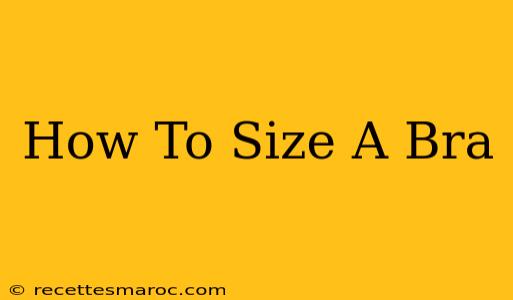Finding the perfect bra can feel like searching for the Holy Grail. An ill-fitting bra can cause discomfort, back pain, and even affect your posture. But fear not! This comprehensive guide will walk you through the process of accurately measuring your bra size and finding the perfect fit. Understanding your bra size is the first step towards comfort and confidence.
Why Knowing Your Bra Size Matters
Before we dive into the measurement process, let's understand why accurately sizing your bra is so crucial:
- Comfort: A properly fitting bra provides support and comfort throughout the day, preventing discomfort and chafing.
- Posture: A supportive bra helps maintain good posture, reducing back and neck pain.
- Appearance: The right bra size enhances your silhouette and makes clothes fit better.
- Health: Improper bra support can lead to long-term health issues.
How to Measure Your Bra Size: A Step-by-Step Guide
Accurately measuring your bra size involves two key measurements: your band size and your cup size.
1. Measuring Your Band Size
This is the measurement around your rib cage, directly under your breasts. Here's how:
- Use a soft measuring tape. Ensure it's not too tight or too loose.
- Wrap the tape measure around your ribcage, keeping it level and snug but not constricting.
- Take the measurement at the end of your exhale. This ensures the most accurate reading.
- Round up to the nearest even number. Bra band sizes are typically even numbers (e.g., 32, 34, 36).
2. Measuring Your Cup Size
This measurement determines the volume of your breasts.
-
Keep the measuring tape at the same level as when you measured your band size.
-
Wrap the tape measure around the fullest part of your bust, ensuring it's level and snug.
-
Subtract your band size measurement from your bust measurement. The difference will determine your cup size:
- 1 inch difference: AA cup
- 2 inch difference: A cup
- 3 inch difference: B cup
- 4 inch difference: C cup
- 5 inch difference: D cup
- 6 inch difference: DD/E cup
- 7 inch difference: DDD/F cup
- and so on...
Important Note: Cup sizes can vary slightly between brands. Don't be afraid to try on a few different sizes and styles to find the best fit for your body.
Understanding Bra Size Charts and Variations
Bra size charts can be helpful, but they're not always perfect. Keep in mind that:
- Different brands have different sizing. What's a 34B in one brand might be a 36A in another.
- Your size may change over time. Due to weight fluctuations, pregnancy, or age, your bra size can change. Regularly check your measurements.
- Your body type impacts fit. Consider your breast shape and how it impacts the overall fit of the bra.
Beyond the Numbers: Finding the Right Fit
Even with accurate measurements, finding the perfect fit might require trying on a few different bras. Here are some things to check:
- The band should sit snugly but not too tight. You should be able to fit two fingers comfortably under the band.
- The cups should completely enclose your breasts without spillage or gaping.
- The straps should not dig into your shoulders. They should support your breasts without causing discomfort.
- The wire should lie flat against your chest. It shouldn't poke or pinch.
Frequently Asked Questions (FAQ)
Q: What should I do if I'm between sizes? It's best to try on both sizes and choose the one that feels more comfortable and supportive.
Q: How often should I measure my bra size? It's recommended to measure your bra size at least once a year, or whenever you notice a change in your body.
Q: Where can I find help with bra fitting? Many department stores and lingerie shops offer professional bra fitting services.
By following these steps and paying attention to how a bra feels, you'll be well on your way to finding the perfect fit and embracing the comfort and confidence that comes with it. Remember, finding the right bra size is a journey, not a destination!

